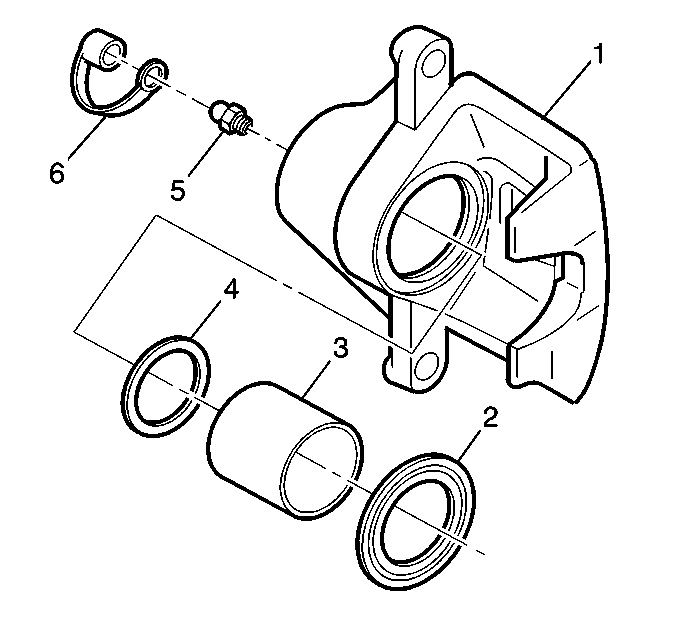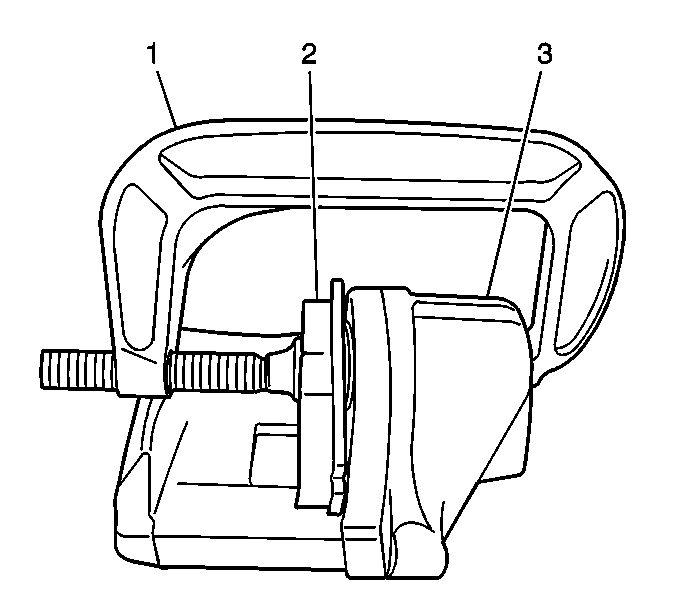Brake Caliper Inspection JL9, JE5
- Inspect the brake caliper housing (1) for cracks, excess wear, and/or damage. If any of these conditions are present, the brake caliper requires replacement.
- Inspect the caliper piston dust boot seal (2) for cracks, tears, cuts, deterioration, and/or improper seating in the caliper body. If any of these conditions are present, the brake caliper requires overhaul or replacement.
- Inspect for brake fluid leakage around the caliper piston dust boot seal (2) and on the disc brake pads. If there is any evidence of brake fluid leakage, the brake caliper requires overhaul or replacement.
- Inspect for smooth and complete travel of the caliper piston, or pistons, into the caliper bore, or bores.
Caution: Refer to Brake Dust Caution in the Preface section.


The movement of a caliper piston into a caliper bore should be smooth and even. If a caliper piston is frozen or difficult to bottom, the caliper requires overhaul or replacement.
| • | For single piston caliper applications, insert a discarded inner brake pad (2) or block of wood in front of the piston. Using a large C-clamp (1) installed over the body of the caliper (3) and against the brake pad or block of wood, slowly bottom the piston in the bore. |
| • | For dual piston caliper applications, insert a discarded inner brake pad (2) or block of wood in front of the pistons. Using 2 large C-clamps (1) installed over the body of the caliper (3) and against the brake pad or block of wood, slowly bottom the pistons evenly into the bores. |
Brake Caliper Inspection J56
- Inspect the brake caliper housing for cracks, excess wear, and/or damage. If any of these conditions are present, the brake caliper requires replacement.
- Inspect the caliper piston dust boot seals for cracks, tears, cuts, deterioration and/or improper seating in the caliper body. If any of these conditions are present, the brake caliper requires overhaul or replacement.
- Inspect for brake fluid leakage around the caliper piston dust boot seals and on the disc brake pads. If there is any evidence of brake fluid leakage, the brake caliper requires overhaul or replacement.
- Inspect for smooth and complete travel of the caliper pistons, into the caliper bores:
- Carefully insert a plastic flat-bladed trim tool between the rotor and inboard brake pad.
- Carefully apply pressure to the inboard brake pad until both caliper inner pistons are fully compressed into the caliper piston bores.
- Carefully insert a plastic flat-bladed trim tool between the rotor and outboard brake pad.
- Carefully apply pressure to the outboard brake pad until both caliper outer pistons are fully compressed into the bores.
Caution: Refer to Brake Dust Caution in the Preface section.
Caution: Refer to Brake Fluid Irritant Caution in the Preface section.
The movement of a caliper pistons into a caliper bores should be smooth and even. If a caliper piston is frozen or difficult to bottom, the caliper requires overhaul or replacement.
Important: Use ONLY a plastic flat-bladed trim tool and/or another suitable soft tool when compressing the caliper pistons into the caliper piston bores. Never use any type of metal tool between the brake rotor and brake pads to compress the caliper pistons into the bores.
